Les Paul Guitars...
Onward and Upward!!
Les Paul guitars in the "Norlin era":
If you have read the Gibson history, you may recall that Gibson's parent company CMI was purchased by ECL, an Ecuadorian brewery in 1969 and the two companies merged to form a company called Norlin.
Norlin retained ownership of Gibson through 1985. This period saw a number of changes made to the Les Paul guitars. The body of the guitars saw the most drastic changes. Due to the neck joints of the guitars
being notoriously weak and easily broken, a neck volute(an extra bump of wood) was added to the neck/headstock joints in order to strengthen them. In addition, the neck woods were changed from mahogany to a 3-piece
neck design to further strengthen the necks. This is a design used on many Ibanez guitars for the same reason. The Les Paul body also received a major revamping. Originally a one-piece mahogany body with a maple top,
the body design was changed multiple slabs of mahogany with multiply pieced maple tops. This is referred to as a "pancake" body.
Les Paul Recording
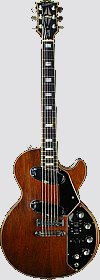
During this period Gibson also began experimenting with "concept" models such as the Les Paul Recording, the Sonix, the Marauder, the L6-5, the L-1 and a number of other models. The Recording was probably the most
"futuristic". The Recording featured low-impedance pickups, many switches and buttons, and a highly specialized cable for impedance-matching to the amplifier. The gadgetry included a pickup selector switch, a bass knob,
a tone selector switch, a treble knob, a high/low impedance switch, an 11 position Decade Control that altered the treble frequencies, a phase switch and, finally, a volume control. All this hardware made for a heavy beast.
The Recording was not a resounding success, as many players regarded it as being too full of gadgetry. Another strike against it as far as Rock players were concerned is that is was designed to be as clean and
noiseless as possible. It made for a nice Jazz guitar but was not really suitable for wailing, screaming Rock.
Les Paul Deluxe:
1972 Les Paul Deluxe
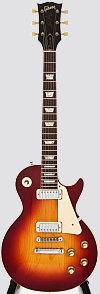
The Les Paul guitars line-up gained another sibling in 1968 - the Les Paul Deluxe. The first of the Les Paul Deluxe models featured "mini-humbuckers" that fit into the pre-carved P-90 cavity by means of an adapter ring which was
basically a trimmed P-90 cover. The main reason Gibson used these was that they had a large supply of the pickups that were left behind after they moved Epiphone production to Japan. The original Deluxe also featured a
one-piece body and a three-piece neck. The Deluxe underwent a number of changes from its introduction through the early 1980s. The 1969 models sported a headstock
logo that didn't have a dot over the "i" in Gibson. In addition, the 1969 models received a "pancake" body and a small volute. In late 1969 the dot over the "i" had returned and a "Made in USA" stamp was added to the back
of the headstock. Around 1975 the neck material was changed from mahogany to maple. By late 1976 or early 1977, the body was changed back to mahogany from the three-piece "pancake" design. Consumers were never fond of the
Deluxe and it was dropped from the Les Paul guitars line-up. However, both Pete Townshend of The Who and Gary Moore of Thin Lizzy both used the Deluxe and it gained enough popularity through its association with them that
Gibson revived it in 1985.
Les Paul Studio:
Les Paul Studio
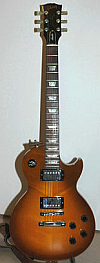
In 1983 the Les Paul guitars line-up gained another sibling. Aimed at studio musicians, the Les Paul Studio did away with the frills and ornamentation of other Les Paul models. Not only is the Studio lighter than other models(it's still in production),
it was designed for optimal sound output, tone and playability. Over the years the Les Paul Studio has seen many changes in materials, finishes and hardware. The years 1983-1985 saw the introduction of three Studio models: the "regular" Les Paul Studio,
the Les Paul Studio Custom and the
Les Paul Studio Standard
. The "Regular" featured an alder body with a carved maple top which contributed to slightly lower build quality than the other two Studios of the time. In addition, the "Regular"
Les Paul Studio didn't have neck and body bindings. The Les Paul Studio Custom followed in 1984, featuring a mahogany body with a carved maple top and a bound mahogany neck. All the Custom's hardware was gold. The Studio Standard immediately followed
the Custom and had virtually the same features. The differences were minor: the hardware was black, the pickguard was painted white and the guitar sported a cherry themed finish.
In the mid-1990s Gibson introduced the Les Paul Studio Lite. Les Paul guitars have always been heavy instruments and players had been requesting a lighter Les Paul. The Lite still used mahogany but was lightened by using balsa wood in various
body sections which lightened the guitar by a great deal. In addition, the Studio Lite had different electronics than its Les Paul brethren. Gibson added a single coil pickup between the traditional humbuckers and modified the controls
so that all five pickup coils could be selected.
On the heels of the Lite, Gibson released the Les Paul Studio Gem Series. The Gem Series featured toned down finishes modeled on certain gemstones. In addition, traditional P-90s were used instead of humbuckers. In my opinion this series
was produced as a marketing gimmick(a tactic Gibson seems intent on continuing to this day). The Gem Series didn't last long. It was discontinued in 1998.
Gibson Goes High Tech:
In 2007 Gibson came out with a guitar version of the infamous Hal from "2001: A Space Odessey". The Les Paul guitars line-up gained three new members out of Gibson's move to high tech - the Gibson Robot Les Paul, the Gibson Dark Fire Les Paul
and the Gibson Dusk Tiger Les Paul. I'm not really sure what prompted this move. Maybe Gibson was trying to take some of the burden off guitarists such as tuning, various aspects of tonal crafting and recording, etc. It's been my experience that
people either love them or disdain them as being gadget filled novelties instead of real player's guitars. Anyway, let's have a look at them.
Gibson Robot Les Paul
Gibson Robot Les Paul
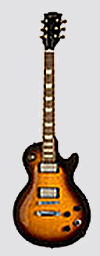
Gibson brought out the first of the new Les Paul guitars models in 2007. Dubbed the "Robot Guitar", it had a computer integrated with the body of the guitar. The computer was controlled with a master control knob situated next to the volume knobs. Pulling the control knob out
allowed the player to get a variety of tunings as well as adjusting the intonation simply by making a selection on the control knob, taking your left hand off the neck and strum until the master control's display tells you the guitar is in tune. It's a very convenient
way to change tunings quickly and the intonation feature can save you a bit of money. Unless you know exactly what you're doing you are going to end up taking your guitar to the shop to be intonated by a professional. The intonation feature
keeps you from having to do that. As for my opinion on the "Robot" genre goes, I'd rather do all that myself. It's not that I'm a technophobe but, in my opinion, it allows the guitarist to get away without a basic understanding, not only of the guitat itself,
but also of basic music theory. Be that as it may, the robot Les Paul guitars have proven to be popular enough that Gibson is still producing them.
The Les Paul Dark Fire:
Gibson Les Paul Dark Fire
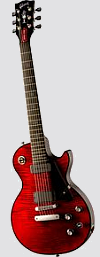
The next entry in Gibson's high tech Les Paul guitars line-up was the Les Paul Dark Fire released in 2008. Like the "Robot". the Dark Fire had a computer integrated into the body of the guitar and controlled by a Master Control Knob. Also, like the "Robot", the Dark Fire featured the
same tuning abilities as the Robot but took things even further. The Dark Fire not only allowed the player to tune the guitar up to 500 times on a single battery charge but also to switch pickups and coils as well. The Dark Fire is capable of doing this even during the performance of a song.
Gibson called all this the "Chameleon Tuning Technology" and claimed that it allowed the player to get any conceivable sound out of the instrument. In addition, the Dark Fire sported three types of pickups: the Burstbucker humbucker, a P-90 single-coil and a bridge-mounted piezo acoustic pickup.
Combine all these features and about the only thing you lack to make the guitar a self-contained recording studio is the ability for the guitar to record itself. This is only my opinion but, here again, I think the Dark Fire is another example of a "gimmick" to attract business by giving guitarists
something unique that other manufacturers didn't have.
The Les Paul Dusk Tiger:
Gibson Les Paul Dusk Tiger

In 2009, following the Dark Fire into the Les Paul guitars "2001 - A Space Odessy" line-up was the Dusk Tiger. The Dusk Tiger had all the "chameleon" features of its predecessor but added programmable 4-band graphic equalizer systems for the magnetic and piezo pickups which allowed even more tonal
possibilities than the Dark Fire possessed, a switchable LP-Z high definition impedance circuit with low impedance capablities built into the Neutrick cable jack and XLR outputs, which are secure 3-wire connectors usually found on high end sound equipment to allow very long cable runs without generating
pickup hum or sound frequency losses, thus improving the sound quality. The Dusk Tiger also sported many body design changes. It retained the the Les Paul shape but sported a tone chambered back with an exotic hardwood top with gold, amber and dark chocolate hues. The Dusk Tiger also featured a revised control
layout and and a very unique looking new pickguard. The Dusk Tiger is probably one of the most eye-catching of the Les Paul guitars, usually producing a "What the #$^% is that?" response from people who've never seen one before. Again, I think it's more gimmick than anything else but that's just my opinion
and you know what they say about opinions.
Conclusion:
In conclusion, just let me say that Gibson Les Paul guitars are deservedly one of the most revered and iconic guitars on the market, gimmickery notwithstanding. Today Gibson has more models of the Les Paul in production than you can shake a stick at. For the last few years Gibson has followed this approach
with many of its guitars, not just the Les Paul guitars. Personally, I think that rather than make 500 versions of a model, make four or five that make sense for various styles and spend your time making them the best that they can be. If you follow Gibson's current approach I think you're going to spread yourself too thin and
that eventually quality is going to drop and the guitar's reputation and appeal is going to suffer. Again, that's my opinion and Gibson apparently doesn't share it. I hope I'm wrong. I don't want to see a venerable instrument line like the Les Paul guitars eventually become a has-been. At any rate, thanks for reading and
I hope you've enjoyed our foray into the history of the Les Paul Guitars.
ROCK ON!













New! Comments
Have your say about what you just read! Leave me a comment in the box below.